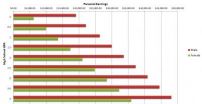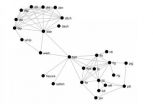(Press-News.org) FREMONT, CA (May 19, 2014): Newly published research demonstrates the ability of BioMAP® Systems, a unique set of primary human cell and co-culture assays that model human disease and pathway biology, to identify important safety aspects of drugs and chemicals more efficiently and accurately than can be achieved by animal testing. Data from BioMAP Systems analysis of 776 environmental chemicals, including reference pharmaceuticals and failed drugs, on their ability to disrupt physiologically important human biological pathways were published online this week in Nature Biotechnology. The results show that this in vitro approach can reproducibly identify potential toxicities and off-target drug effects, as well as pinpoint cellular mechanisms and specifically affected biomarker endpoints underlying specific types of adverse reactions in humans. DiscoveRx Corporation's BioSeek division conducted the analysis in collaboration with scientists from the U.S. Environmental Protection Agency as part of the EPA ToxCast Program.
Assessing the safety aspects of drugs, consumer products and environmental chemicals has been historically undertaken through animal testing. However, the vast number of chemicals needing such toxicological assessment and the fact that results in animals often do not translate well to results in humans require the development of alternative, faster, more accurate and humane testing approaches.
"This publication examines an unprecedentedly large data set in terms of number of chemicals, chemical diversity and types of assays screened phenotypically in BioMAP primary human cell models of tissue biology and disease," said Ellen L. Berg, Ph.D., Scientific Director and General Manager of DiscoveRx's BioSeek division and an author of the publication. "In contrast to screening approaches aimed at understanding the actions of a single agent at the molecular and mechanistic level, this method harvests the collective knowledge embedded in reference chemicals with respect to their molecular targets, mechanisms of action, and animal and human toxicity and applies it to characterizing the biological activity of new chemicals or medicines.
"Our results show such systems to be a highly useful and reproducible tool for predictive toxicology that can identify potential chemical targets, toxicological liabilities and molecular mechanisms that elucidate specific adverse outcome pathways for drugs and other chemicals," Dr. Berg continued. "Even using a limited set of primary human cell systems, we were able to recognize consistent patterns of activity that were closely correlated with diverse drug actions and toxicities. New chemicals falling into profile clusters with known activities suggest specific potential toxicities for more careful evaluation, greatly increasing the efficiency of toxicity testing by focusing resources for follow-up testing on the bioactivities of highest concern."
For example, drugs and chemicals, including selective estrogen receptor modulators, tamoxifen and raloxifene, that are associated with thrombosis-related side effects, like deep vein thrombosis (DVT), were found to preferentially increase the levels of tissue factor in BioMAP models of vascular inflammation. Thus, the use of these models for screening earlier in the drug discovery process may help identify new medicines with reduced potential for this debilitating side effect.
Building on the Vision
"DiscoveRx's vision now is to further build the BioMAP database with additional compounds, types of data, and cellular models, thus broadening the utility of this approach for both predictive toxicology and drug discovery research, "Dr. Berg said. "This includes annotated, collated public data of compound clinical effects combined with exposure and compound metabolism information on drugs and chemicals, as well as data on compounds at multiple testing concentrations. To that end, we are continuing the effort begun by the ToxCast Initiative to assemble a pharmaceutical industry consortium that will contribute compounds in order to generate an unprecedented industry resource that can help drug developers better understand the potential risks and benefits of their compounds and why they might succeed or fail, before entering the clinic."
"Failed drugs, especially those that fail in costly later stages of clinical testing, represent a serious and expensive problem for pharmaceutical and biotechnology companies," said Sailaja Kuchibhatla, Executive Vice President for DiscoveRx Corporation. "Thus the ability to better predict and understand potential safety issues associated with drugs before they enter animal or human testing is an important industry need. DiscoveRx's continued efforts to make BioMAP Systems an essential industry resource reflect our ongoing mission of providing drug developers with the best tools, information and expert services to meet the pharmaceutical and biotechnology industry's most pressing needs, both today and tomorrow."
INFORMATION:
About the EPA ToxCast Program
The EPA ToxCast program launched in 2007, is a multiyear effort that uses high-throughput screening assays to test thousands of chemicals for potential toxicity. In 2013, ToxCast publicly released screening data on 2,000 chemicals from a broad range of sources, including industrial and consumer products, food additives, and potentially "green" chemicals that could be safer alternatives to existing chemicals. These chemicals were evaluated in more than 700 high-throughput assays covering a range of high-level cell responses and approximately 300 signaling pathways. EPA's Endocrine Disruptor Screening Program already has begun the scientific review process necessary to begin using ToxCast data to prioritize the thousands of chemicals that need to be tested for potential endocrine-related activity. For more information, visit http://epa.gov/ncct/toxcast/.
About DiscoveRx Corporation
DiscoveRx develops and markets industry-leading products, technology and scientific expertise worldwide to accelerate the successful discovery and development of safer, more effective therapeutics and chemicals. The company's innovative research platforms, products, knowledge content and scientific expertise support both phenotypic and target-based approaches and enable DiscoveRx customers to address key questions across the R&D process, from target identification through preclinical development, toxicology testing and beyond.
DiscoveRx's capabilities are encompassed by its three proprietary technology platforms. Utilizing these proprietary platforms, DiscoveRx has developed and commercialized industry leading panels of over 1000 target-based and primary cell-based assay systems for Oncology, Metabolic Disease, Inflammation, CNS and Cardiovascular drug discovery research.
DiscoveRx is a privately held, venture-backed company headquartered in Fremont, California, with additional offices in San Diego, CA, South San Francisco, CA and Birmingham, England. For more information on the company, please visit our website at http://www.discoverx.com, and to learn more about the objectives of the consortium, contact skuchibhatla@discoverx.com.
Company Contact
DiscoveRx Corporation
Sailaja Kuchibhatla
Executive Vice President
tel | 510.979.1415 x102
skuchibhatla@discoverx.com
Media Contact
Kureczka/Martin Associates
Joan Kureczka
Tel: 415.821,2413
Joan@kureczka-martin.com
EPA ToxCast data validates BioMAP® systems' ability to predict drug, chemical toxicities
DiscoveRx creating global pharmaceutical consortium to expand predictive toxicology resource
2014-05-19
ELSE PRESS RELEASES FROM THIS DATE:
Fluoridating water does not lower IQ: New Zealand research
2014-05-19
New research out of New Zealand's world-renowned Dunedin Multidisciplinary Study does not support claims that fluoridating water adversely affects children's mental development and adult IQ.
The researchers were testing the contentious claim that exposure to levels of fluoride used in community water fluoridation is toxic to the developing brain and can cause IQ deficits. Their findings are newly published in the highly respected American Journal of Public Health.
The Dunedin Study has followed nearly all aspects of the health and development of around 1000 people born ...
Chinese scientists crack the genome of another diploid cotton Gossypium arboreum
2014-05-19
Shenzhen, May 18, 2014---Chinese scientists from Chinese Academy of Agricultural Sciences and BGI successfully deciphered the genome sequence of another diploid cotton-- Gossypium arboreum (AA) after the completed sequencing of G. raimondii (DD) in 2012. G. arboreum, a cultivated cotton, is a putative contributor for the A subgenome of cotton. Its completed genome will play a vital contribution to the future molecular breeding and genetic improvement of cotton and its close relatives. The latest study today was published online in Nature Genetics.
As one of the most ...
The young sperm, poised for greatness
2014-05-19
SALT LAKE CITY— In the body, a skin cell will always be skin, and a heart cell will always be heart. But in the first hours of life, cells in the nascent embryo become totipotent: they have the incredible flexibility to mature into skin, heart, gut, or any type of cell.
It was long assumed that the joining of egg and sperm launched a dramatic change in how and which genes were expressed. Instead, new research shows that totipotency is a step-wise process, manifesting as early as in precursors to sperm, called adult germline stem cells (AGSCs), which reside in the testes. ...
'Smoking gun' evidence for theory that Saturn's collapsing magnetic tail causes auroras
2014-05-19
University of Leicester researchers have captured stunning images of Saturn's auroras as the planet's magnetic field is battered by charged particles from the Sun.
The team's findings provide a "smoking gun" for the theory that Saturn's auroral displays are often caused by the dramatic collapse of its "magnetic tail".
Just like comets, planets such as Saturn and the Earth have a "tail" – known as the magnetotail – that is made up of electrified gas from the Sun and flows out in the planet's wake.
When a particularly strong burst of particles from the Sun hits Saturn, ...
Solar energy prospects are bright for Scotland, experts say
2014-05-19
Installing state-of-the-art solar panels on a quarter of a million roofs could meet one-sixth of Scotland's electricity demands, experts say.
Scientists say the strategy could ease the plight of one in three Scottish households, which currently struggle to provide themselves with adequate heat and hot water.
Researchers, business leaders and public sector experts have contributed to a report which sets out how Scotland could benefit from solar power.
They say harnessing energy from the sun on the roofs of south-facing buildings could have significant economic, ...
Antarctica's ice losses on the rise
2014-05-19
Three years of observations show that the Antarctic ice sheet is now losing 159 billion tonnes of ice each year – twice as much as when it was last surveyed.
A team of scientists from the UK Centre for Polar Observation and Modelling, led by researchers at the University of Leeds, have produced the first complete assessment of Antarctic ice sheet elevation change.
They used measurements collected by the European Space Agency's CryoSat-2 satellite mission, which carries an altimeter specially designed for this task.
In sharp contrast to past altimeter missions, CryoSat-2 ...
Sanofi Pasteur announces favorable Phase II data for investigational C. difficile vaccine
2014-05-19
Boston, United States of America – May 19, 2014 – Sanofi Pasteur, the vaccines division of Sanofi (EURONEXT: SAN and NYSE: SNY), presented Phase II (H-030-012) trial results for an investigational vaccine for the prevention of Clostridium difficile (C. diff) infection (CDI) at the 114th General Meeting of the American Society for Microbiology (ASM). The Phase II trial met its primary objectives, reactions were generally mild and of short duration, and the candidate vaccine generated an immune response against C. diff toxins A and B. These toxins are largely responsible ...
Your high school GPA could affect your income
2014-05-19
Coral Gables, Fla. (May 19, 2014)—A team of researchers led by Michael T. French, professor of health economics at the University of Miami (UM), finds that high school grade point average (GPA) is a strong predictor of future earnings.
The findings, published recently in the Eastern Economic Journal, show that a one-point increase in high school GPA raises annual earnings in adulthood by around 12 percent for men and 14 percent for women.
Although previous studies have found a relationship between higher levels of education and greater earnings, less is known about ...
Keywords hold vocabulary together in memory
2014-05-19
Much like key players in social networks, University of Kansas scientists have found evidence that there are keywords in word networks that hold together groups of words in our memory.
In a study published in the Journal of Memory and Language, Michael Vitevitch, KU professor of psychology, showed that research participants recognized these keywords more quickly and accurately than other words that were like the keywords in many respects except for their position in a network of 20,000 similar-sounding English words that he and colleagues created in 2008.
"If words ...
National heart organizations join to combat the global hypertension epidemic
2014-05-19
NEW YORK, N.Y., May 19, 2014: It's estimated that more than 970 million people have hypertension1 and, globally, the disease is responsible for more than nine million deaths every year, making it one of the leading causes of death worldwide. In an effort to help manage the epidemic, leading scientists from the American Society of Hypertension (ASH), American Heart Association (AHA) and the Centers for Disease Control and Prevention (CDC) convened a joint panel to discuss a global project aiming to improve the treatment and control of hypertension worldwide.
The joint ...
LAST 30 PRESS RELEASES:
University of Oklahoma researcher awarded funding to pursue AI-powered material design
Exploring how the visual system recovers following injury
Support for parents with infants at pediatric check-ups leads to better reading and math skills in elementary school
Kids’ behavioral health is a growing share of family health costs
Day & night: Cancer disrupts the brain’s natural rhythm
COVID-19 vaccination significantly reduces risk to pregnant women and baby
The role of vaccination in maternal and perinatal outcomes associated with COVID-19 in pregnancy
Mayo Clinic smartwatch system helps parents shorten and defuse children's severe tantrums early
Behavioral health spending spikes to 40% of all children’s health expenditures, nearly doubling in a decade
Digital cognitive behavioral treatment for generalized anxiety disorder
Expenditures for pediatric behavioral health care over time and estimated family financial burden
Air conditioning in nursing homes and mortality during extreme heat
The Alps to lose a record number of glaciers in the next decade
What makes a good proton conductor?
New science reporting guide published for journalists in Bulgaria
New international study reveals major survival gaps among children with cancer
New science reporting guide published for journalists in Turkey
Scientists develop a smarter mRNA therapy that knows which cells to target
Neuroanatomy-informed brain–machine hybrid intelligence for robust acoustic target detection
Eight SwRI hydrogen projects funded by ENERGYWERX
The Lundquist Institute and its start-up company Vitalex Biosciences Announces Strategic Advancement of Second-Generation fungal Vaccine VXV-01 through Phase 1 Trials under $40 Million Competitive Con
Fine particles in pollution are associated with early signs of autoimmune disease
Review article | Towards a Global Ground-Based Earth Observatory (GGBEO): Leveraging existing systems and networks
Penn and UMich create world’s smallest programmable, autonomous robots
Cleveland researchers launch first major study to address ‘hidden performance killer’ in athletes
To connect across politics, try saying what you oppose
Modulating key interaction prevents virus from entering cells
Project explores barriers to NHS career progression facing international medical graduates
Jeonbuk National University researchers explore the impact of different seasonings on the flavor perception of Doenjang soup
Two Keck Medicine of USC Hospitals named Leapfrog Top Teaching Hospitals
[Press-News.org] EPA ToxCast data validates BioMAP® systems' ability to predict drug, chemical toxicitiesDiscoveRx creating global pharmaceutical consortium to expand predictive toxicology resource



